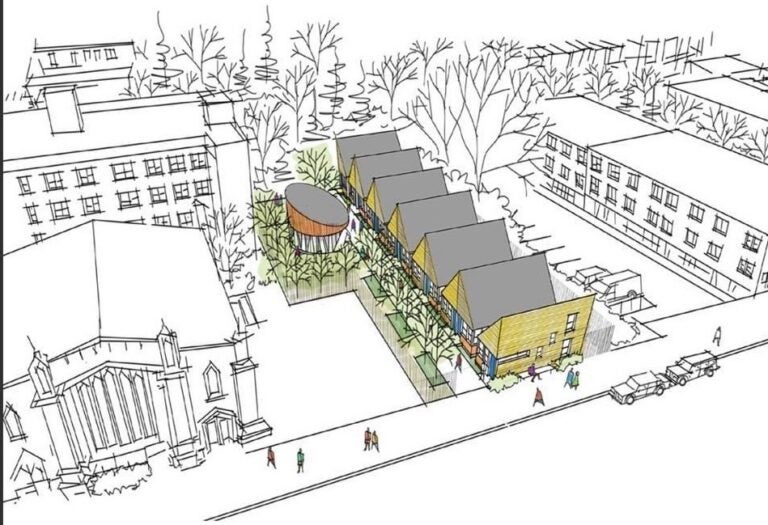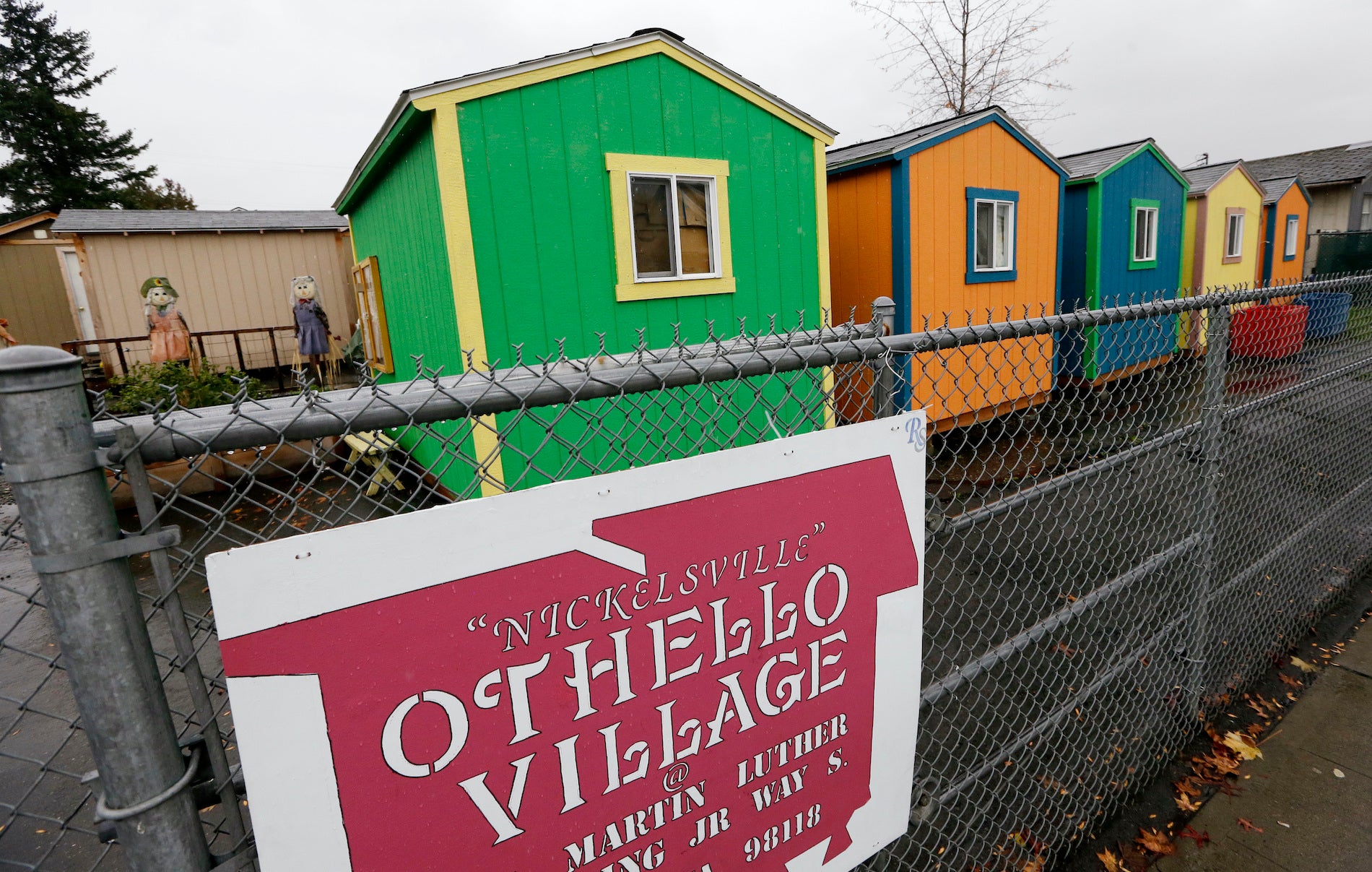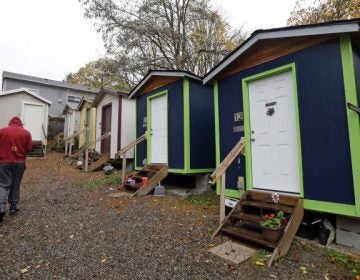Philly advocates push Pa. lawmakers to adopt tiny homes building codes
In Philadelphia, tiny houses are burdensome to build. A change to state building code would eliminate hurdles, advocates say.

Student-Run Emergency Housing Unit of Philadelphia's project proposal for the Mill Creek Aspen Street Tiny Village. (Courtesy of SREHUP)
Updated at 6:11 p.m.
Stephanie Sena, arguably one of the city’s most animated housing advocates, has spent years trying to build tiny houses in Philadelphia.
Now, at the end of an otherwise grim 2020, the Villanova poverty and policy professor appears to have gotten the city backing she needs to see one of her visions realized.
Sena and her organization, Student-Run Emergency Housing Unit of Philadelphia, is one of the would-be developers who responded to a city request for proposals to build a village of tiny houses in the Mill Creek section of West Philadelphia. The RFP came out in November after city officials agreed to build the homes in negotiation with activists protesting homelessness through encampments on Benjamin Franklin Parkway and Ridge Avenue. At its peak, over 200 people lived in the encampments before activists and the city brokered the deal that included the tiny homes and 50 vacant homes that will be fixed up for habitation.
All proposals are due next month and city officials expect the project to be completed by the summer. Those proposals will be reviewed by a scoring committee and then presented to the Philadelphia Redevelopment Authority Board for consideration. The committee is made up of representatives of different city agencies.
In the meantime, Sena is setting her sights on trying to make it easier for tiny houses to come elsewhere in Philly and across the state through adopting a new regulation that would make it easier to build homes 400 square feet or less.
“If legislation is passed, it streamlines the process and it makes it easier for more people to build more affordably,” Sena said. “When it comes to building codes, it’s better to be less exclusionary because it opens us to more diverse and affordable building options.”
Appendix Q allows for lower ceilings, lofts
The regulation, known as Appendix Q, passed in 2018 into the international residential building code that guides the construction codes imposed by local governments. In the years since, several states including Massachusetts and California have adopted it into the state building code that municipalities use.
In Philadelphia and elsewhere in the state, tiny houses can be burdensome to build because residences of such diminutive stature aren’t covered by the construction code.
Under the current building codes, homes that are 400 square feet and under can get a building permit with no fuss as long as rooms meet proper dimensions and the ceiling heights meet the minimum requirements. However, if a plan calls for a lower ceiling height, which is typical of tiny houses, and the use of loft space, the builder must secure a variance — a costly and time-consuming process that doesn’t always end with a green light to build. Appendix Q would change that by adding sleeping lofts and ceilings as low as six feet into the standard building code so no extra approvals would be needed.
“If we were to get Appendix Q, it would allow more flexibility and better use of the area and volume within a tiny house,” said Dave Perri, the former commissioner of the city’s Department of Licenses and Inspection. Perri, who retired in October, had argued for changes to the city code that would enable more legal options for non-traditional housing.
Dan Fitzpatrick presides over the Tiny Home Industry Association, the industry group that crafted the building code amendment. He said changing the code creates an opening for developers to build more dwellings for less money.
“They’re perfect for affordable and sustainable housing,” Fitzpatrick said of the tiny homes enabled by Appendix Q.
State Sen. Tim Kearney, who represents parts of Chester and Delaware counties is an architecture professor at Drexel University. He supports the bill but said it will take some convincing for his colleagues outside of the city to get on board. Kearney, who has built two tiny houses himself, is up for the challenge.
“Things like the homeless situation exist everywhere across the Commonwealth but it’s just more hidden in places that are not so dense,” Kearney said.
He and others in Harrisburg will be watching the tiny houses planned for Philadelphia, he said. The success of those projects could sway public opinion in support of the change of code.

Tiny houses as a housing solution
If Sena is chosen for the Mills Creek project, her goal is to eventually transform the property into a land trust and the houses to a limited equity cooperative. Her plan would allow a path for residents to rent or own, she said.
The tiny houses planned for West Philadelphia will rise at 4917 Aspen St. on a large vacant lot. The city is still looking for another location, likely in the Northeast, officials said.
The city wants both locations to be large enough to accommodate 10 or more properties and have access to transportation. One site is expected to offer transitional rental housing while the other will serve as permanent housing.
Under Sena’s plan, the Mill Creek village would consist of 12 two-bedroom tiny houses under 400 square feet with bathrooms, kitchens and utilities. It would cost about $1.2 million. Most of the houses would be wheelchair accessible.
It’s too early to know who will be chosen to go into the tiny villages, city officials said. The Office of Homeless Services will choose the recipients. People who were in the encampment don’t have any preferential treatment and people who are more susceptible to COVID-19 with underlying conditions are more likely to be chosen.
Sena said the tiny houses represent “one tool in the toolbox.”
“It might not even be the most effective housing solution and it’s not for everyone,” she said. “Tiny houses are one relatively affordable and fast way to increase the inventory of affordable housing.”
Building more public housing and rehabbing already existing homes are other solutions, but usually more expensive, she said.
The Mill Creek homes are coming to an area deeply in need of affordable housing, said City Councilmember Jamie Gauthier, who represents the district. A recent report issued by her office found that more than half of renters in her West Philly district spend more than a third of their income on rent.
The councilmember welcomes the tiny homes and supports the adoption of Appendix Q.
“Ultimately, we’re dealing with a shortage of housing that’s within the reach of people who live here and a change to the building code will help us address that need better,” she said.
If Sena wins the contract to build the homes, Malaika Hart-Gilpin, co-founder of One Art Community Center in West Philly, hopes to partner with her as a builder. Hart-Gilpin’s organization has already built a few tiny houses and the planned dwellings would go up next to one of their partner farms, Mill Creek Urban Farm.
Hart-Gilpin said this needs to happen because it’s the right thing to do.
“These are our brothers and sisters that are experiencing this and it’s not acceptable especially with the abundance of resources,” she said.
Ebonie Camp, born and raised in Philadelphia, is another housing advocate and she supports the project because she thinks everyone deserves the right to their own space.
She experienced homelessness twice in her life while having two young daughters. She believes that anything that can help the affordable housing crisis should be pursued.
“No one wants to be homeless,” she said. “Everyone wants a roof over their head.”

Subscribe to PlanPhilly
WHYY is your source for fact-based, in-depth journalism and information. As a nonprofit organization, we rely on financial support from readers like you. Please give today.







